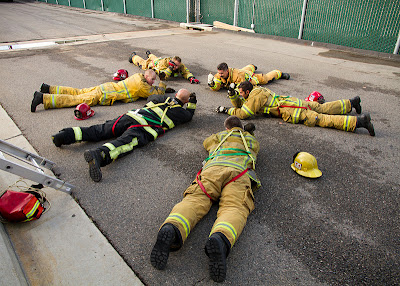First, let me say that I was impressed with the answers that I received regarding the photo in my last post. The responses that I received from firefighters were correct, and the ones that I received from non-fire service readers were well thought out and was based on observation. Well done!
The photo was of the "ground school" portion of a ladder bail class. As the ladder bail requires following a precise procedure to perform safely, students are required to demonstrate proficiency on the ground before being allowed to perform it above ground. Serious injuries have occurred during training on this evolution, showing a need for safety guidelines and training procedures for it.
The ladder bail (low profile above ground ladder escape) has been widely taught in one form or another since the late 80s. It is an evolution that requires very precise movements, as the consequences of an error are dire.
The objective is to rapidly egress an upper floor window, while keeping as low as possible in the window frame. It is not to be performed for fun, but should only be used when the flames are licking at your ass and you have no control of the situation. They call it a bail-out for a reason.
The images and captions below document a recent "train the trainer" session, covering the ladder bail procedure and the set-up for teaching the class. The "students" are peer instructors, who assist the training division in training crews on their shifts. As at least 12 multi-company drills covering this evolution will be performed, it is important that everyone is getting the same material. Hence this session.
Step 1: Find the window sill.
Step 2: Find the beams.
Step 3: Slide the beams.
Step 4: Hook rung #2 and make a fist.
Step 5: Slide beam with other hand and find 4th rung.
Step 6: Slide rung to the opposite beam.
Step 7: Feet together, kick your own ass and swing out.
Step 8: Find rails with your feet and slide down.
Obviously, there are other bits of important information that need to be instructed, but you get the idea. Another tool for firefighters to put in the box, just in case.
If you have never taken a safety/survival course teaching this evolution, I urge you to do so. Just make sure that the instructor is qualified to teach this, the consequences of failure are great.
Thanks for reading and have a happy Thanksgiving.
Schmoe
Exercise Snacks: Fitness Appetizers for Firefighters
13 hours ago











Ah ha!
ReplyDeleteThe only video I've seen of a bail-out had the FF sliding down face first. Mind you it was amateur video of a working fire gone bad so the FF in question may not have been trained in the proper technique.
BGM
Well BG, I am sure that the firefighter you saw in the video knows the right way to do it now!
ReplyDeleteFortunately, I never had to use this stuff and am glad of it.
Thanks for the comments, BG
I know I'm late to the party on this one, I haven't been keeping up with blogger as often as I'd like. I mainly just had to comment about these guys using the sling-link as their safety harness.
ReplyDeleteI bought the exact same product a few years ago. I used to put it on the waist belt of my pack every morning. Time went on and I stopped, call it laziness if you want, I'll own up to that. I've trained my guys on it for extrication by dragging a victim. I've played around trying to climb the sling link (they say you can but it's hard to get your foot in or out of a loop that's weighted).
This is the first time I've seen one used during training instead of a hasty-harness or real harness. When I was taught this ladder bail (we call it a 'hook 2, grab 4'), we ran the waist belt of our scotts between our legs and the safety line was tied to our pack. We taught the waist-belt trick for anything that required lifting or dragging a downed fireman.
Sadly, we no longer have scott packs. The new junk, yes, junk, isn't capable of this trick. I honestly wouldn't trust it on the new junk anyways.